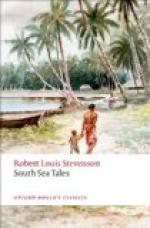CHAPTER VI—THE KING OF APEMAMA: DEVIL-WORK
The ocean beach of Apemama was our daily resort. The coast is broken by shallow bays. The reef is detached, elevated, and includes a lagoon about knee-deep, the unrestful spending-basin of the surf. The beach is now of fine sand, now of broken coral. The trend of the coast being convex, scarce a quarter of a mile of it is to be seen at once; the land being so low, the horizon appears within a stone-cast; and the narrow prospect enhances the sense of privacy. Man avoids the place—even his footprints are uncommon; but a great number of birds hover and pipe there fishing, and leave crooked tracks upon the sand. Apart from these, the only sound (and I was going to say the only society), is that of the breakers on the reef.
On each projection of the coast, the bank of coral clinkers immediately above the beach has been levelled, and a pillar built, perhaps breast-high. These are not sepulchral; all the dead being buried on the inhabited side of the island, close to men’s houses, and (what is worse) to their wells. I was told they were to protect the isle against inroads from the sea—divine or diabolical martellos, probably sacred to Taburik, God of Thunder.
The bay immediately opposite Equator Town, which we called Fu Bay, in honour of our cook, was thus fortified on either horn. It was well sheltered by the reef, the enclosed water clear and tranquil, the enclosing beach curved like a horseshoe, and both steep and broad. The path debouched about the midst of the re-entrant angle, the woods stopping some distance inland. In front, between the fringe of the wood and the crown of the beach, there had been designed a regular figure, like the court for some new variety of tennis, with borders of round stones imbedded, and pointed at the angles with low posts, likewise of stone. This was the king’s Pray Place. When he prayed, what he prayed for, and to whom he addressed his supplications I could never learn. The ground was tapu.
In the angle, by the mouth of the path, stood a deserted maniap’. Near by there had been a house before our coming, which was now transported and figured for the moment in Equator Town. It had been, and it would be again when we departed, the residence of the guardian and wizard of the spot—Tamaiti. Here, in this lone place, within sound of the sea, he had his dwelling and uncanny duties. I cannot call to mind another case of a man living on the ocean side of any open atoll; and Tamaiti must have had strong nerves, the greater confidence in his own spells, or, what I believe to be the truth, an enviable scepticism. Whether Tamaiti had any guardianship of the Pray Place I never heard. But his own particular chapel stood farther back in the fringe of the wood. It was a tree of respectable growth. Around it there was drawn a circle of stones like those that




